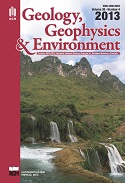CO2-brine-rock interactions as a result of long term experiment onto rock samples from Chabowo anticline, Poland
DOI:
https://doi.org/10.7494/geol.2013.39.4.385Keywords:
CO2 -brine-rock interactions, CO2 sequestration, petrophysical investigation, petrology- -mineralogical characteristics, Chabowo anticlineAbstract
The presented work concerns investigations of CO2 -brine-rock interactions conducted over a period of 20-months. Experiments were carried out at laboratory scale with the use of equipment specifically designed for this purpose. Research materials (reservoir and cap rocks) were taken from the Chabowo 3 well located within Chabowo anticline. The experiments were carried out at room temperature (about 25ºC) and pressure about 6 MPa. For samples before and after the experiment a numerous investigations were carried out i.e. petrophysical (porosity, surface area, threshold diameter, average capillary, framework and bulk densities) and petrological-mineralogical characteristics. Also brine used for examination before and after experiment was analyzed (chemical analysis). Petrophysical results have shown a significant decrease of porosity (from 17.0% to 7.5%) and surface area (from 0.395 m2 /g to 0.196 m2 /g) in case of sandstone. These changes are caused probably by crystallization of halite in pore spaces, because mineralogical analysis (XRD) has shown the presence of halite (3–5% vol. in the rock) after experiment. More detailed results were obtained during mineralogical analyses of thin sections. These results have shown in sandstone samples a small increase of porosity and a small decrease of feldspar and cements (carbonate and clay) as well as matrix which suggests dissolution of these constituents. For claystone – after experiment XRD clay fraction has shown absence of clay minerals such as montmorillonite, which may also be caused by interaction between the rock, CO2 and brine. Dissolution of some minerals is evidenced by chemical analysis of brine where amounts of most tested ions increase after experiment for both sandstone and claystone.
Downloads
References
Birkholzer J.T. & Zhou Q., 2009. Basin-scale hydrogeologie impacts of CO2 storage: capacity and regulatory implications. International Journal of Greenhouse Gas Control, 3, 6, 745-756.
Fischer S., Liebscher A., Wandrey M. & the CO2SINK Group, 2010. CO2-brine-rock interaction - First results of long-term exposure experiments at in situ P-T conditions of the Ketzin CO reservoir. Chemie der Erde/Geochemistry, 70, S3, 155-164.
Gaus I., Azaroual M. & Czernichowski-Lauriol I., 2005. Reactive transport modelling of the impact of CO2 injection on the clayey caprock at Sleipner (North Sea). Chemical Geology, 217, 319-337.
Gunter W.D., Perkins E.H. & Hutcheon I., 2000. Aquifer disposal of acid gases: modelling of water-rock reactions for trapping of acid wastes. Applied Geochemistry, 15, 8, 1085-1095.
Gunter W.D., Perkins E.H. & Mccann T. J., 1993. Aquifer disposal of CO2-rich gases reaction design for added capacity. Energy Conversion and Management, 34, 941-948.
IPCC, 2005. Special report of the intergovernmental panel on climate change on carbon dioxide capture and storage [Metz B., Davidson O., de Coninck H.C., Loos M., Meyer L. A. (eds.)]. New York.
IPCC, 2007. Climate Change 2007. Synthesis Report. Contribution of Working Groups I, II and III to the Fourth Assessment Report of the Intergovernmental Panel on Climate Change [Core Writing Team, Pachauri R.K & Reisinger A. (eds)]. IPCC, Geneva, Switzerland.
Labus K., 2009. Modeling hydrochemical effects of carbon dioxide sequestration in saline aquifer of the upper Silesian coal basin. Wydawnictwo Politechniki Śląskiej, Gliwice.
Labus K., Wdowin M. & Tarkowski R., 2010. Assessment of CO2 sequestration capacity based on hydrogeochemical model of Water-Rock-Gas interactions in the potential storage site within the Bełchatów area (Poland). Gospodarka Surowcami Mineralnymi - Mineral Resources Management, 26, 2, 69-84.
Muller N., Qib R., Mackiea E., Pruessc K. & Blunt M.J., 2009. CO2 injection impairment due to halite precipitation. Energy Procedia, 1, 1, 3507-3514.
Pang Z., Kong Y., Li Y. & Li J., 2013. Water-rock interaction in CO2 sequestration in a depleted oil reservoir pilot test. Procedia Earth and Planetary Science, 7, 656-659.
Pettijohn F.J., Potter P.E. & Siever R., 1972. Sand and sandstone. Springer-Verlag, New York.
Soong Y., Goodman A.L., McCarthy-Jones J.R. & Baltrus J.P., 2004. Experimental and simulation studies on mineral trapping of CO2 with brine. Energy Conversion and Management, 45, 11-12, 1845-1859.
Tarkowski R. (red.), 2010. Potencjalne struktury geologiczne do składowania CO2 w utworach mezozoiku Niżu Polskiego (charakterystyka oraz ranking) [Potential geological structures to CO2 storage in the Mesozoic Polish Lowlands (characteristics and ranking)]. Studia, Rozprawy, Monografie 164, IGSMiE PAN, Kraków.
Tarkowski R. & Wdowin M., 2011. Petrophysical and Mineralogical Research on the Influence of CO2 Injection on Mesozoic Reservoir and Caprocks from the Polish Lowlands. Oil & Gas Science and Technology - Revue d'IFP Energies nouvelles, 66, 1, 137-150.
Wdowin M., Tarkowski R. & Manecki M., 2013. Petrographic-mineralogical and textural changes in reservoir and sealing rocks (Zaosie anticline) as a result of a long-term experiment in CO2-brine-rock interactions. Gospodarka Surowcami Mineralnymi - Mineral Resources Management, 29, 4, 137-154.
Wdowin M., Tarkowski R. & Franus W., 2014. Supplementary studies of textural and mineralogical changes in reservoir and cap rocks from selected potential sites suitable for underground CO2 storage. The Arabian Journal for Science and Engineering, 39, 1, 295-309.
Zeidouni M., Pooladi-Darvish M. & Keith D., 2009. Analytical Solution to Evaluate Salt Precipitation during CO2 Injection in Saline Aquifers. Energy Procedia, 1, 1, 1775-1782.
Zhang W., Xu T. & Li Y., 2011. Modeling of fate and transport of Co-injection of H2S with CO2 in deep saline formations. Journal of Geophysical Research, 116, B02202.
Downloads
Published
Issue
Section
License
Authors have full copyright and property rights to their work. Their copyrights to store the work, duplicate it in printing (as well as in the form of a digital CD recording), to make it available in the digital form, on the Internet and putting into circulation multiplied copies of the work worldwide are unlimited.
The content of the journal is freely available according to the Creative Commons License Attribution 4.0 International (CC BY 4.0)










